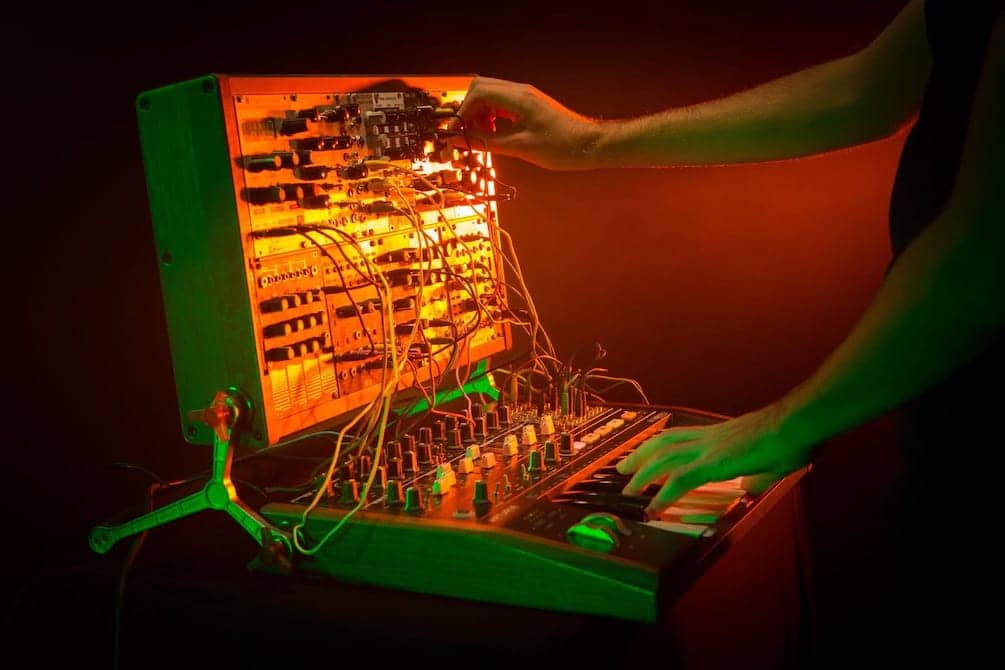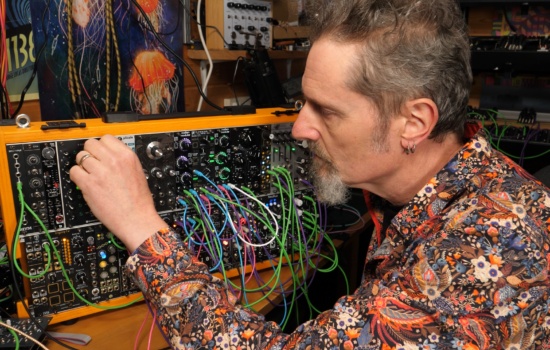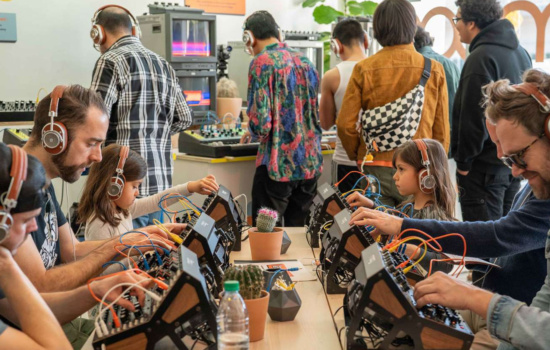First of all, what do we mean by “Eurorack”? Eurorack is a fairly loose format of modular hardware synthesis that’s based upon the patching up of individual sound generating and manipulating modules. It was created by Dieter Doepfer in the 1990s and is based in analog technology — (although the modules do not have to be analog) invented by Moog, Buchla and other synthesizer companies in the 1970s — that uses Control Voltage (CV) as the method of controlling parameters.
It has some key standards in the physical size of the modules so that they fit into standard sized “racks.” They are connected via front-mounted patch cables based on 1/8” mono jacks. The CV is usually ranged between +-5V. You do not need to understand what that is or why it’s what it is; all you need to grasp is that if you connect the CV output of an LFO module to the CV input of a filter module, the LFO will control the cut-off. Your audio signal is also patched using the exact same cables in the same way.
To get started in Eurorack, you are going to need to understand a couple of basic modular synthesis concepts:
- You won’t get any sound out unless you patch it together to make sound.
- It won’t behave like a hardware synthesizer unless you patch it together to do that.
- Modular can have a steep learning curve.
- To “patch” is to connect two things with a cable.
And then you need to know a few of the basic building blocks that form what we generally regard as a synthesizer. If you are used to hardware or software synthesizers, then these blocks or modules will be familiar to you as synthesizer components, but you might not have interacted with them quite so individually before. Synthesizers do all the wiring in the background for us so we never really have to consider how an envelope interacts with a filter, just that something happens when I turn this knob. Eurorack will give you a thorough understanding of how all these things work.
Most basic synthesizers consist of the following five modules:
- VCO — Voltage Controlled Oscillator. This is what generates the sound and is often a sine wave, triangle, sawtooth or pulse/square wave.
- VCF— Voltage Controlled Filter. Our favorite sound shaping tool; the filter.
- VCA— Voltage Controlled Amplifier. Acts as a volume control for the VCO although it has a lot of other useful applications.
- ADSR— or Envelope. This controls the shape of the volume of the VCO, although you can apply that shape to all sorts of things.
- LFO — Low-Frequency Oscillator. This provides CV modulation on the parameters of other modules. You could see it as the mod wheel on your hardware synth.
One of Eurorack’s greatest attributes is the ability to patch anything into anything else. It’s not always appropriate, but you’ll find that almost everything can be something else or do more than the basic thing it was intended for. For instance, a VCO can become an LFO, a VCF can oscillate, a VCA can control the level of CV, and an Envelope can become a looping waveform. But that’s probably going too far too quickly. Let’s stick with the basics and the leave the more advanced stuff to your own journey of discovery.
So, let’s look at how these five modules interact and become a “synthesizer.”
With a regular synthesizer, you press a key on the keyboard, and you hear a sound at that pitch for as long as you hold the key — this is normal and expected. In Eurorack, those simple connections are no longer there, and you have to adopt a broader understanding of what’s going on. An oscillator (VCO) is sounding all the time, there’s no on/off switch, and when you play a note it doesn’t turn the oscillator on as it’s already playing. If you connect the waveform output on a VCO to the audio output you’ll hear a constant drone.
So, what your keyboard is doing is opening a Gate on the VCA. (It controls the volume right?) Press a key, and it sends a positive voltage to the CV input on the VCA which opens it up, and we hear the sound of the VCO coming through. Let go of the key, and the Gate closes, and we no longer hear the sound. The key press acts on the VCA, not the VCO.
The Gate opening of a VCA is a bit basic and inexpressive, so instead, we can use an ADSR to shape the volume control of the VCA. ADSR stands for Attack (how fast the sound comes in), Decay (how fast the sound goes away), Sustain (the level as long as the key is held) and Release (how quickly the sound fades). So for a fast bass sound, you might have a fast Attack, high Sustain, no Release. For a pad sound, you might have a slow Attack, long Decay, and long Release. So, in our synth voice, we patch the keyboard to the Gate of the ADSR, and this gives us a much more controllable shape to the volume of the sound.
Secondly, with CV the pitch is not defined by the keyboard, it’s defined by the tuning knob on the VCO. All the keyboard does is add voltage to the pitch control on the VCO and is defined as 1 Volt being equivalent to an octave change. So, pressing middle C on your keyboard will not result in hearing a middle C from the VCO unless you have tuned it and set the voltage coming from the keyboard to achieve this. This appears to be a bit complicated until you realize that the piano keyboard is not a native of the Eurorack world.
Although you can use them either through a MIDI-to-CV interface or if the keyboard has its own CV outputs, but you are more likely to be using a Eurorack-based sequencer. A sequencer generates a series of voltages which move the pitch of the VCO relative to what it’s been tuned to. So, this automatic connection we make between a piano keyboard and a synthesizer is one of the many assumptions we must let go of when starting in Eurorack.
The VCF is a bit more obvious, though. The waveform from the output of the VCO plugs straight into it before going to the VCA — that’s easy. The less obvious question is how do you modulate the cut-off? Well, you can do this with the LFO using the sine wave output to sweep the cut-off. The LFO might have other waveforms as well that you can use for added variety. Or you can use the ADSR to control the filter the same as it’s controlling the VCA.
That’s all five modules working together in the most basic ways, but it’s just a place to start. Once free from the shackles of pre-patched synthesizers the possibilities and module choices start to become limitless. You can add in Sequencers not just to control pitch but to control modulation; you can combine LFOs into all sorts of shapes, you can add in randomization and chance, introduce rhythm with triggers and gate sequencers and then start modulating oscillators with other oscillators. And so it goes on.
But back to the original question of how you get started. There are, I believe, three main ways to begin.



